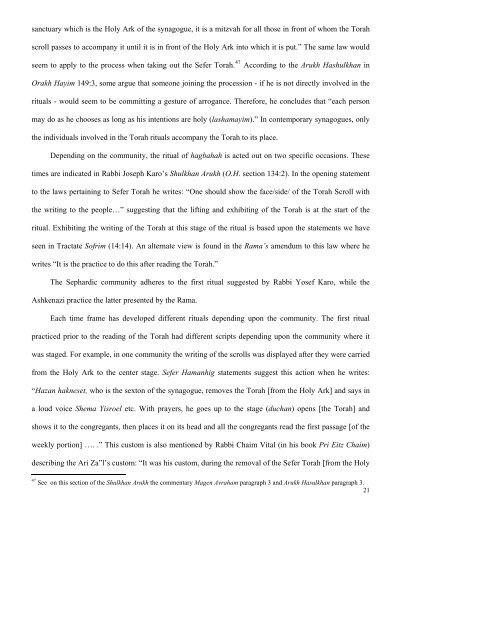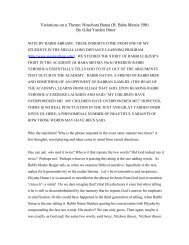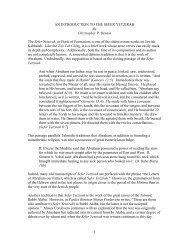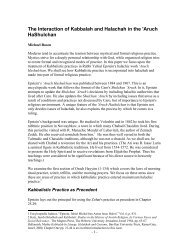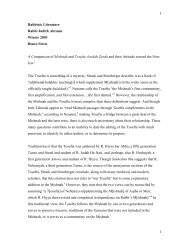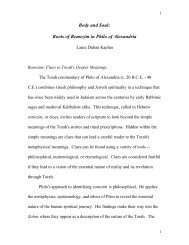The Symbolic Representation of the Sefer Torah - Maqom
The Symbolic Representation of the Sefer Torah - Maqom
The Symbolic Representation of the Sefer Torah - Maqom
Create successful ePaper yourself
Turn your PDF publications into a flip-book with our unique Google optimized e-Paper software.
sanctuary which is <strong>the</strong> Holy Ark <strong>of</strong> <strong>the</strong> synagogue, it is a mitzvah for all those in front <strong>of</strong> whom <strong>the</strong> <strong>Torah</strong>scroll passes to accompany it until it is in front <strong>of</strong> <strong>the</strong> Holy Ark into which it is put.” <strong>The</strong> same law wouldseem to apply to <strong>the</strong> process when taking out <strong>the</strong> <strong>Sefer</strong> <strong>Torah</strong>. 47 According to <strong>the</strong> Arukh Hashulkhan inOrakh Hayim 149:3, some argue that someone joining <strong>the</strong> procession - if he is not directly involved in <strong>the</strong>rituals - would seem to be committing a gesture <strong>of</strong> arrogance. <strong>The</strong>refore, he concludes that “each personmay do as he chooses as long as his intentions are holy (lashamayim).” In contemporary synagogues, only<strong>the</strong> individuals involved in <strong>the</strong> <strong>Torah</strong> rituals accompany <strong>the</strong> <strong>Torah</strong> to its place.Depending on <strong>the</strong> community, <strong>the</strong> ritual <strong>of</strong> hagbahah is acted out on two specific occasions. <strong>The</strong>setimes are indicated in Rabbi Joseph Karo’s Shulkhan Arukh (O.H. section 134:2). In <strong>the</strong> opening statementto <strong>the</strong> laws pertaining to <strong>Sefer</strong> <strong>Torah</strong> he writes: “One should show <strong>the</strong> face/side/ <strong>of</strong> <strong>the</strong> <strong>Torah</strong> Scroll with<strong>the</strong> writing to <strong>the</strong> people…” suggesting that <strong>the</strong> lifting and exhibiting <strong>of</strong> <strong>the</strong> <strong>Torah</strong> is at <strong>the</strong> start <strong>of</strong> <strong>the</strong>ritual. Exhibiting <strong>the</strong> writing <strong>of</strong> <strong>the</strong> <strong>Torah</strong> at this stage <strong>of</strong> <strong>the</strong> ritual is based upon <strong>the</strong> statements we haveseen in Tractate S<strong>of</strong>rim (14:14). An alternate view is found in <strong>the</strong> Rama’s amendum to this law where hewrites “It is <strong>the</strong> practice to do this after reading <strong>the</strong> <strong>Torah</strong>.”<strong>The</strong> Sephardic community adheres to <strong>the</strong> first ritual suggested by Rabbi Yosef Karo, while <strong>the</strong>Ashkenazi practice <strong>the</strong> latter presented by <strong>the</strong> Rama.Each time frame has developed different rituals depending upon <strong>the</strong> community. <strong>The</strong> first ritualpracticed prior to <strong>the</strong> reading <strong>of</strong> <strong>the</strong> <strong>Torah</strong> had different scripts depending upon <strong>the</strong> community where itwas staged. For example, in one community <strong>the</strong> writing <strong>of</strong> <strong>the</strong> scrolls was displayed after <strong>the</strong>y were carriedfrom <strong>the</strong> Holy Ark to <strong>the</strong> center stage. <strong>Sefer</strong> Hamanhig statements suggest this action when he writes:“Hazan hakneset, who is <strong>the</strong> sexton <strong>of</strong> <strong>the</strong> synagogue, removes <strong>the</strong> <strong>Torah</strong> [from <strong>the</strong> Holy Ark] and says ina loud voice Shema Yisroel etc. With prayers, he goes up to <strong>the</strong> stage (duchan) opens [<strong>the</strong> <strong>Torah</strong>] andshows it to <strong>the</strong> congregants, <strong>the</strong>n places it on its head and all <strong>the</strong> congregants read <strong>the</strong> first passage [<strong>of</strong> <strong>the</strong>weekly portion] …. .” This custom is also mentioned by Rabbi Chaim Vital (in his book Pri Eitz Chaim)describing <strong>the</strong> Ari Za”l’s custom: “It was his custom, during <strong>the</strong> removal <strong>of</strong> <strong>the</strong> <strong>Sefer</strong> <strong>Torah</strong> [from <strong>the</strong> Holy47 See on this section <strong>of</strong> <strong>the</strong> Shulkhan Arukh <strong>the</strong> commentary Magen Avraham paragraph 3 and Arukh Hasulkhan paragraph 3.21


